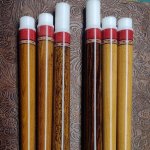Thanks for the reply, Joey. Your post seems to have a little bit of information in it. Let me point out: amongst other generalities you say Hydex 202 is harder than ABS. That may be, but hardness is generally described using numbers such as shore hardness, Moh's hardness etc. Can you direct us to actual hardness numbers supporting your claims? If not, you should qualify your statements with "IMO", "I think" etc so they don't appear as statements of fact. Also, this thread is about low deflection ferrules for carbon shafts. Does your statement "For ferrules, I won't use them because I feel Hydex 202 and mason micarta are better." contemplate the low deflection characteristics of those materials, which is the subject of this thread?You tested a joint collar , didn't you ?
For ferrules, I won't use them because I feel Hydex 202 and mason micarta are better .
Harder, better machinability as in higher melting temp .
Hydex polishes better and doesn't shows sanding marks as bad as ABS.
In this thread we've stumbled onto the consideration of using ABS for low deflection ferrule purpose. Since ABS (and Hydex 202) are not included in DZ's list of low deflection materials, I emailed him this morning asking him to include those materials. Also in that correspondence I mused as to the origin of the numbers in his list. Below is the content of that email which some may find informative and of benefit to this thread pending an update to DZ's low deflection ferrule materials list. FYI, I anticipate your Hydex 202 being assigned a value of about 1.92 in DZ's list and a value of about 1.6 for ABS.
"Hello Bob! For years you've been a great contributor to the cue building community. I've learned a lot from you. Thanks!! Your list of commonly used ferrule material ranks ferrule materials according their "lightness", for lack of a better word, I'm not sure where the numbers come from that you assign to the various materials, but your "Updated list . . ." indicate that if I wish to have a material added to the list (I do, ABS) I can send you specs including the diameter, length and weight in grams. I notice those specs are the same specs necessary to calculate density (weight/volume). So, I'm thinking your chart depicts density numbers which are scaled by a multiplier resulting in the number one (1) being assigned to maple. Since the density of various maples clusters around .6 g/cm3, I suspect you use a multiplier of roughly 1.6 to adjust your maple sample's density to a value of 1 for use in your chart. Of course, that same multiplier is used to adjust the values of the other materials in your list, based on their density. Since the density of ABS is approx 1 gm.cm3, I anticipate you will assign it a value of approximately 1.6 for inclusion in your chart. I hope you can find time to reply to my musings here but, regardless, please include ABS, with density of 1g/cm3, in your Updated list of the most commonly used ferrule materials. Thank you, Henry Fletcher" (I Also asked Mr. Zuricky to include Hydex 202 in a separate email.)

